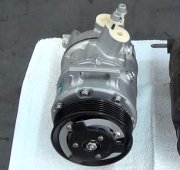An A/C system that blows cold air for awhile then warm air is probably freezing up. This can be caused by air and moisture in the system that allows ice to form and block the orifice tube.
Evacuating the system with a vacuum pump will purge it of unwanted air and moisture. Evacuation should be done with a vacuum pump that is capable of achieving and holding a high vacuum (29 inches) for at least 30 to 45 minutes.
For best performance, an A/C system should contain less than 2% air by weight. For every 1% increase in the amount of air that displaces refrigerant in the system, there will be a corresponding drop of about one degree in cooling performance. More than 6% air can cause a very noticeable drop in cooling performance, and possibly cause evaporator freeze-up.
Air can get inside a system through leaks, by not evacuating the system prior to recharging it, and/or by recharging the system with refrigerant that is contaminated with air. Recovery equipment can suck air into the recycling tank if an A/C system contains air or if the system has a leak. For this reason, the refrigerant recovery tank on recycling equipment must be checked and purged daily. On some equipment, this is done automatically. But on equipment that lacks an automatic purge cycle, tank pressure and temperature has to be measured and compared to a static pressure reference chart.
Some refrigerant identifier equipment can detect air in the system as well as other contaminants. An identifier should be used to check the refrigerant before the system is serviced to prevent cross-contamination of recovery and recycling equipment.
Possible causes of intermittent cooling in a manual A/C system that might be caused by an electrical problem include:
Faulty low pressure cutout switch. This switch prevents the compressor from running if the refrigerant level is low. If the cutout switch is not reading correctly, it can prevent the compressor from coming on.
Faulty compressor clutch. The magnetic clutch on the compressor requires full battery voltage to engage. If the voltage to the clutch is low, or the clutch coils have too much resistance, or the air gap in the clutch is too great, the clutch may not engage to drive the compressor.
Faulty compressor clutch relay. Check to see if the relay is receiving voltage when the A/C is turned on. Also check the relay wiring and ground connections. If bypassing the relay with a jumper wire or routing battery voltage directly to the compressor clutch makes the A/C work, the relay is probably bad.
Faulty A/C control switch. The switch may be worn and not making good contact when it is turned on.
Some possible causes of intermittent cooling (or no cooling) on automatic A/C systems include all of the above, plus:
A problem in the control module or control head (this usually requires using a dealer scan tool to read fault codes and perform self-diagnostics).
A bad temperature sensor (an ambient air temperature sensor, interior air temperature sensor, evaporator temperature sensor, or sunload sensor). Again, a factory scan tool is usually required to perform diagnostics on the system.
Monday, July 27th, 2009 AT 8:35 PM


